Strategic Planning: Business Mission, Core Competencies and Techniques
VerifiedAdded on 2023/03/30
|12
|1000
|94
Essay
AI Summary
This essay provides a comprehensive overview of business strategy, emphasizing the importance of assessing an organization's mission, vision, objectives, goals, and core competencies in strategic planning. It discusses the significance of mission and vision statements in communicating goals to employees and highlights the need for specific, measurable objectives. The essay also examines factors to consider when formulating a strategic plan, including the level of economic development, availability of resources and techniques, and political and social factors. Furthermore, it evaluates techniques such as SWOT and PEST analysis for developing effective strategic business plans. The document is available on Desklib, a platform offering a range of AI-based study tools and resources for students.

Business Strategy
Paraphrase This Document
Need a fresh take? Get an instant paraphrase of this document with our AI Paraphraser
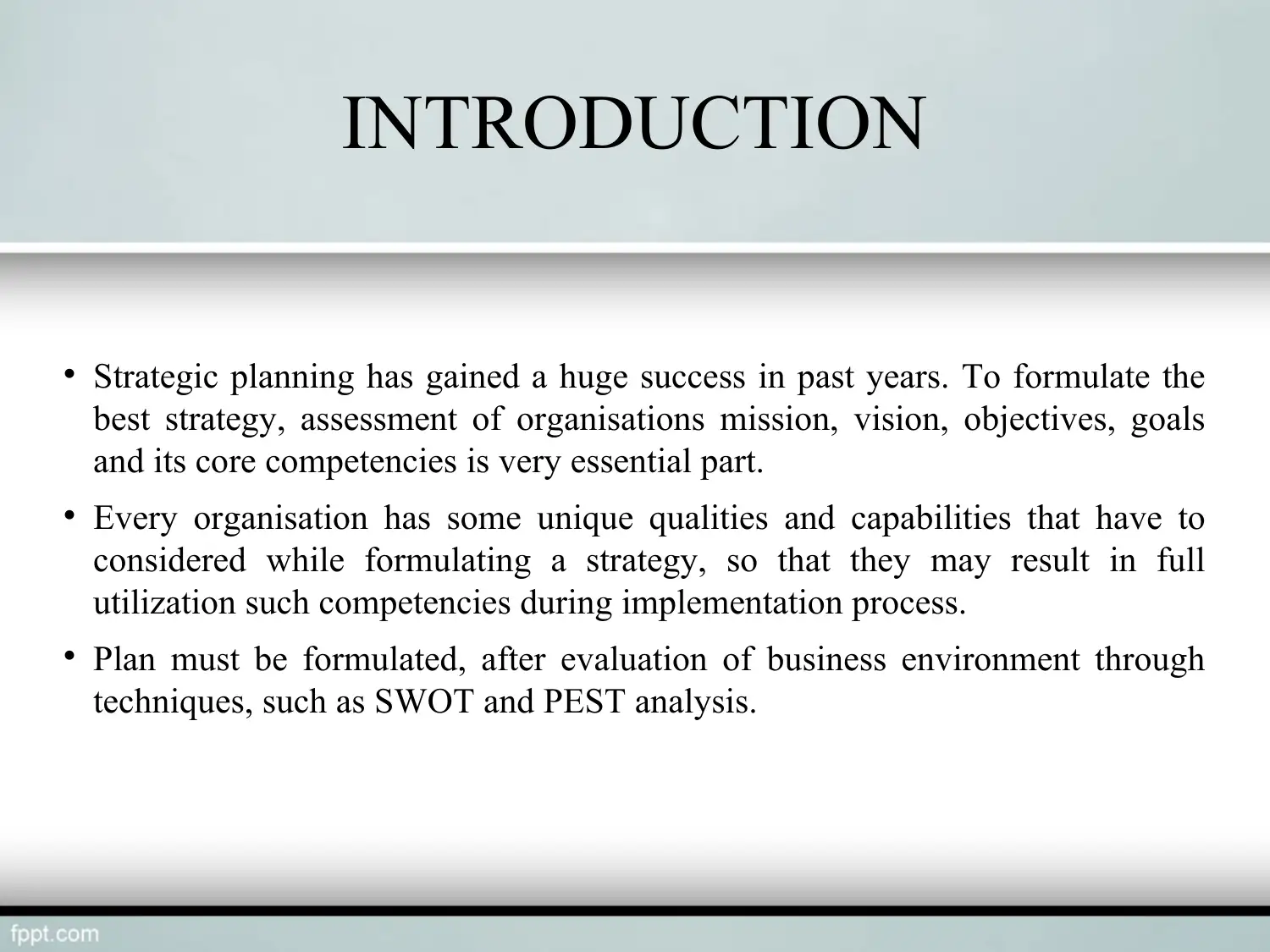
INTRODUCTION
Strategic planning has gained a huge success in past years. To formulate the
best strategy, assessment of organisations mission, vision, objectives, goals
and its core competencies is very essential part.
Every organisation has some unique qualities and capabilities that have to
considered while formulating a strategy, so that they may result in full
utilization such competencies during implementation process.
Plan must be formulated, after evaluation of business environment through
techniques, such as SWOT and PEST analysis.
Strategic planning has gained a huge success in past years. To formulate the
best strategy, assessment of organisations mission, vision, objectives, goals
and its core competencies is very essential part.
Every organisation has some unique qualities and capabilities that have to
considered while formulating a strategy, so that they may result in full
utilization such competencies during implementation process.
Plan must be formulated, after evaluation of business environment through
techniques, such as SWOT and PEST analysis.
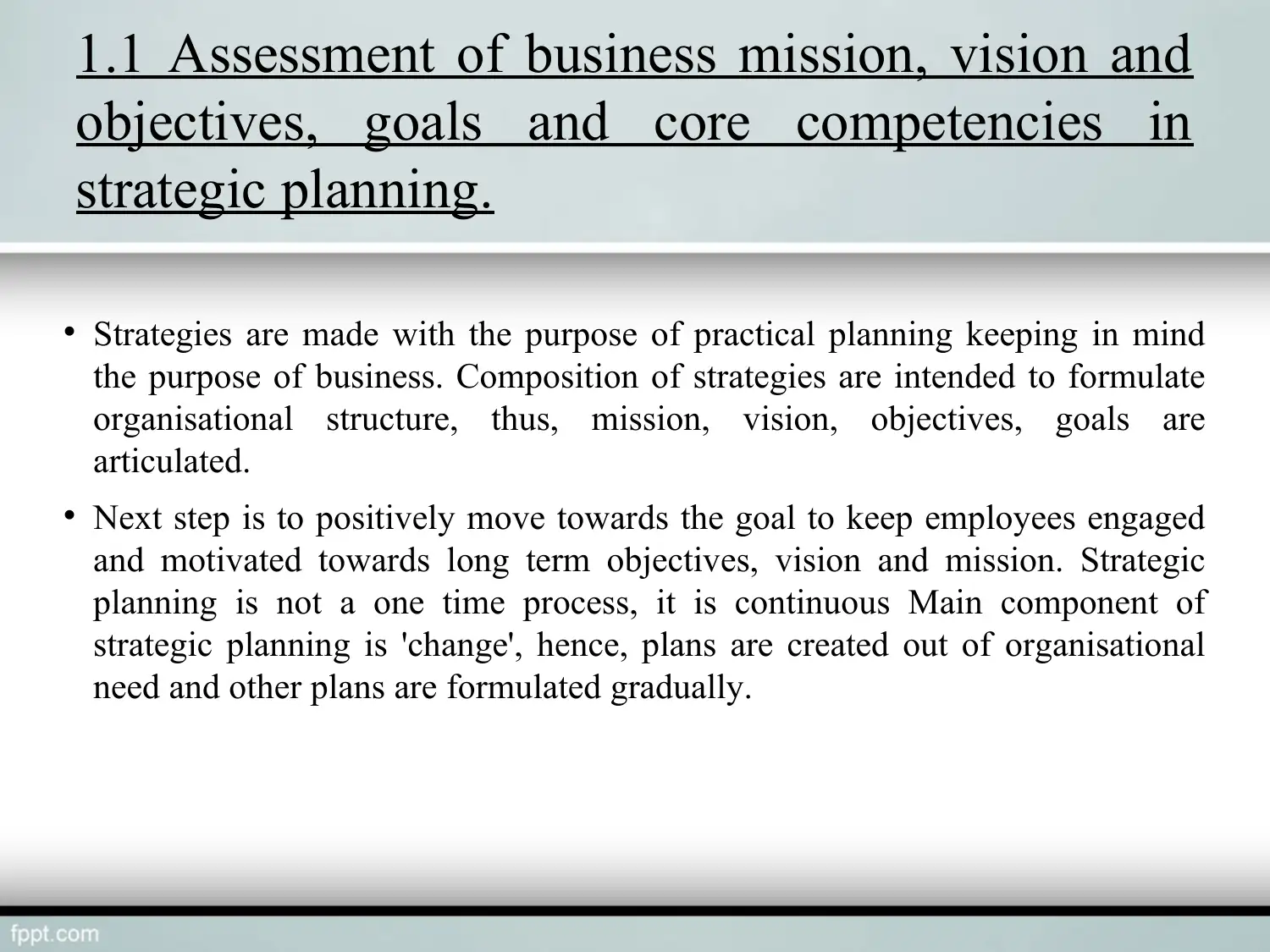
1.1 Assessment of business mission, vision and
objectives, goals and core competencies in
strategic planning.
Strategies are made with the purpose of practical planning keeping in mind
the purpose of business. Composition of strategies are intended to formulate
organisational structure, thus, mission, vision, objectives, goals are
articulated.
Next step is to positively move towards the goal to keep employees engaged
and motivated towards long term objectives, vision and mission. Strategic
planning is not a one time process, it is continuous Main component of
strategic planning is 'change', hence, plans are created out of organisational
need and other plans are formulated gradually.
objectives, goals and core competencies in
strategic planning.
Strategies are made with the purpose of practical planning keeping in mind
the purpose of business. Composition of strategies are intended to formulate
organisational structure, thus, mission, vision, objectives, goals are
articulated.
Next step is to positively move towards the goal to keep employees engaged
and motivated towards long term objectives, vision and mission. Strategic
planning is not a one time process, it is continuous Main component of
strategic planning is 'change', hence, plans are created out of organisational
need and other plans are formulated gradually.
⊘ This is a preview!⊘
Do you want full access?
Subscribe today to unlock all pages.

Trusted by 1+ million students worldwide
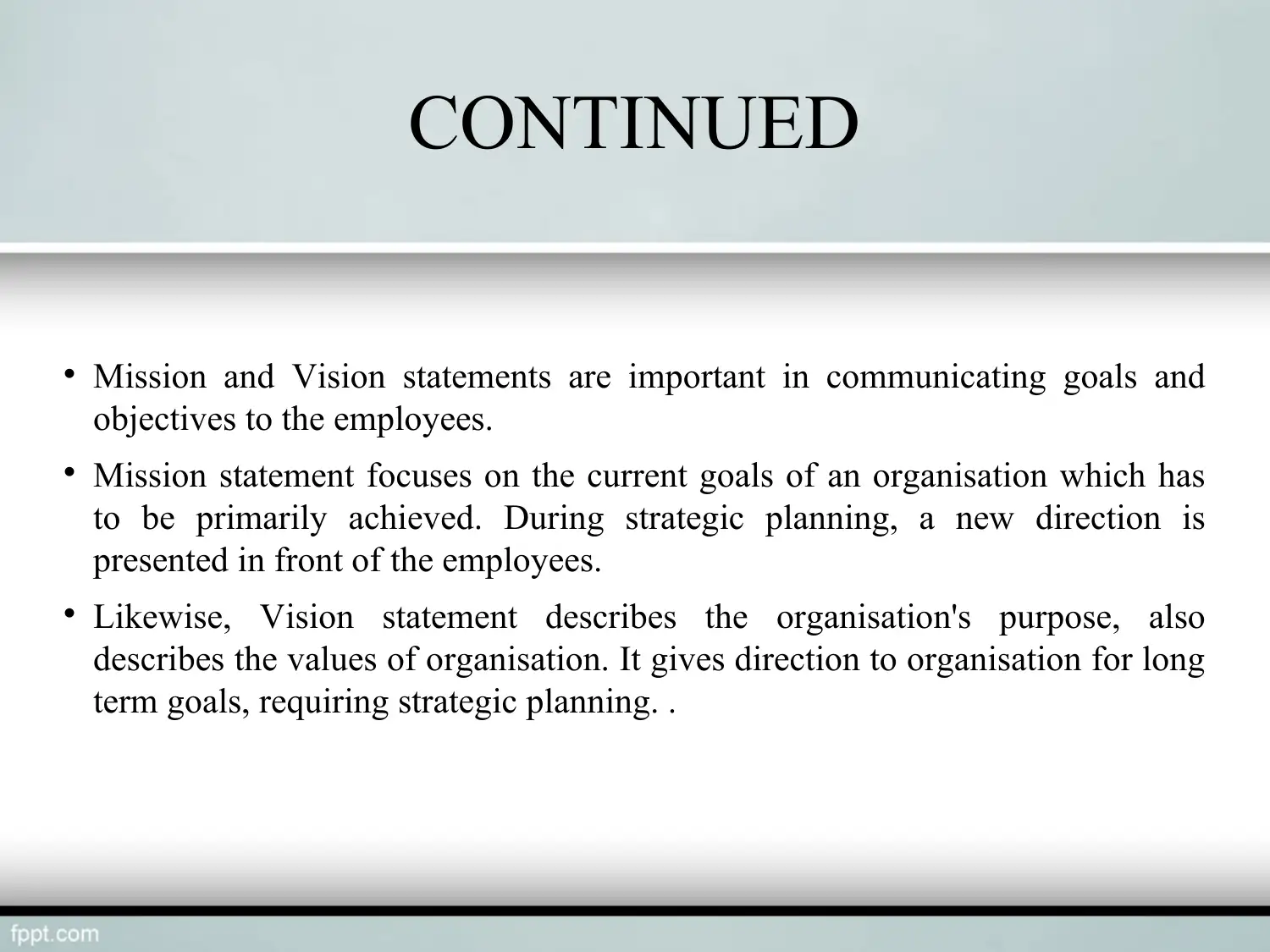
CONTINUED
Mission and Vision statements are important in communicating goals and
objectives to the employees.
Mission statement focuses on the current goals of an organisation which has
to be primarily achieved. During strategic planning, a new direction is
presented in front of the employees.
Likewise, Vision statement describes the organisation's purpose, also
describes the values of organisation. It gives direction to organisation for long
term goals, requiring strategic planning. .
Mission and Vision statements are important in communicating goals and
objectives to the employees.
Mission statement focuses on the current goals of an organisation which has
to be primarily achieved. During strategic planning, a new direction is
presented in front of the employees.
Likewise, Vision statement describes the organisation's purpose, also
describes the values of organisation. It gives direction to organisation for long
term goals, requiring strategic planning. .
Paraphrase This Document
Need a fresh take? Get an instant paraphrase of this document with our AI Paraphraser
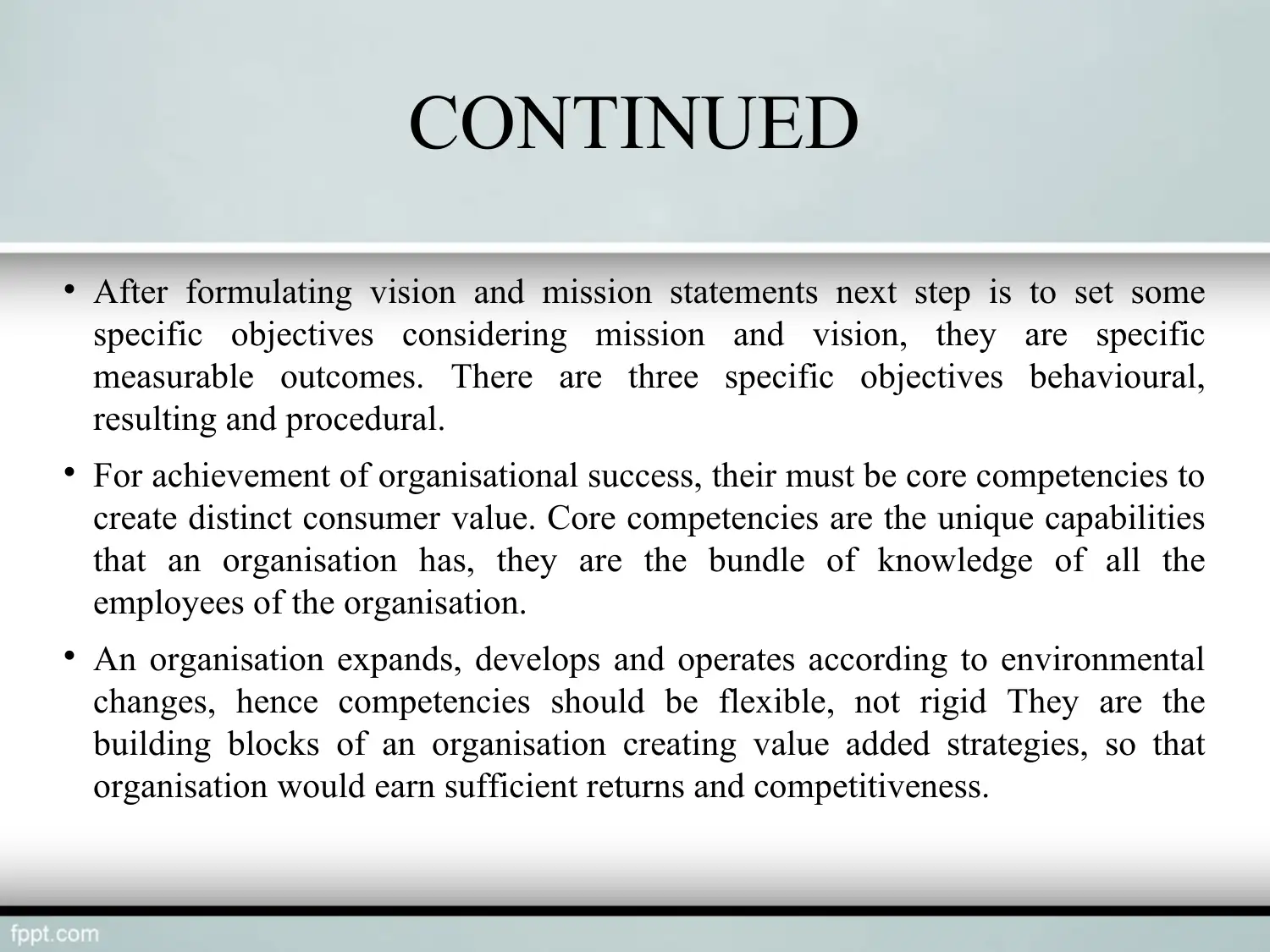
CONTINUED
After formulating vision and mission statements next step is to set some
specific objectives considering mission and vision, they are specific
measurable outcomes. There are three specific objectives behavioural,
resulting and procedural.
For achievement of organisational success, their must be core competencies to
create distinct consumer value. Core competencies are the unique capabilities
that an organisation has, they are the bundle of knowledge of all the
employees of the organisation.
An organisation expands, develops and operates according to environmental
changes, hence competencies should be flexible, not rigid They are the
building blocks of an organisation creating value added strategies, so that
organisation would earn sufficient returns and competitiveness.
After formulating vision and mission statements next step is to set some
specific objectives considering mission and vision, they are specific
measurable outcomes. There are three specific objectives behavioural,
resulting and procedural.
For achievement of organisational success, their must be core competencies to
create distinct consumer value. Core competencies are the unique capabilities
that an organisation has, they are the bundle of knowledge of all the
employees of the organisation.
An organisation expands, develops and operates according to environmental
changes, hence competencies should be flexible, not rigid They are the
building blocks of an organisation creating value added strategies, so that
organisation would earn sufficient returns and competitiveness.
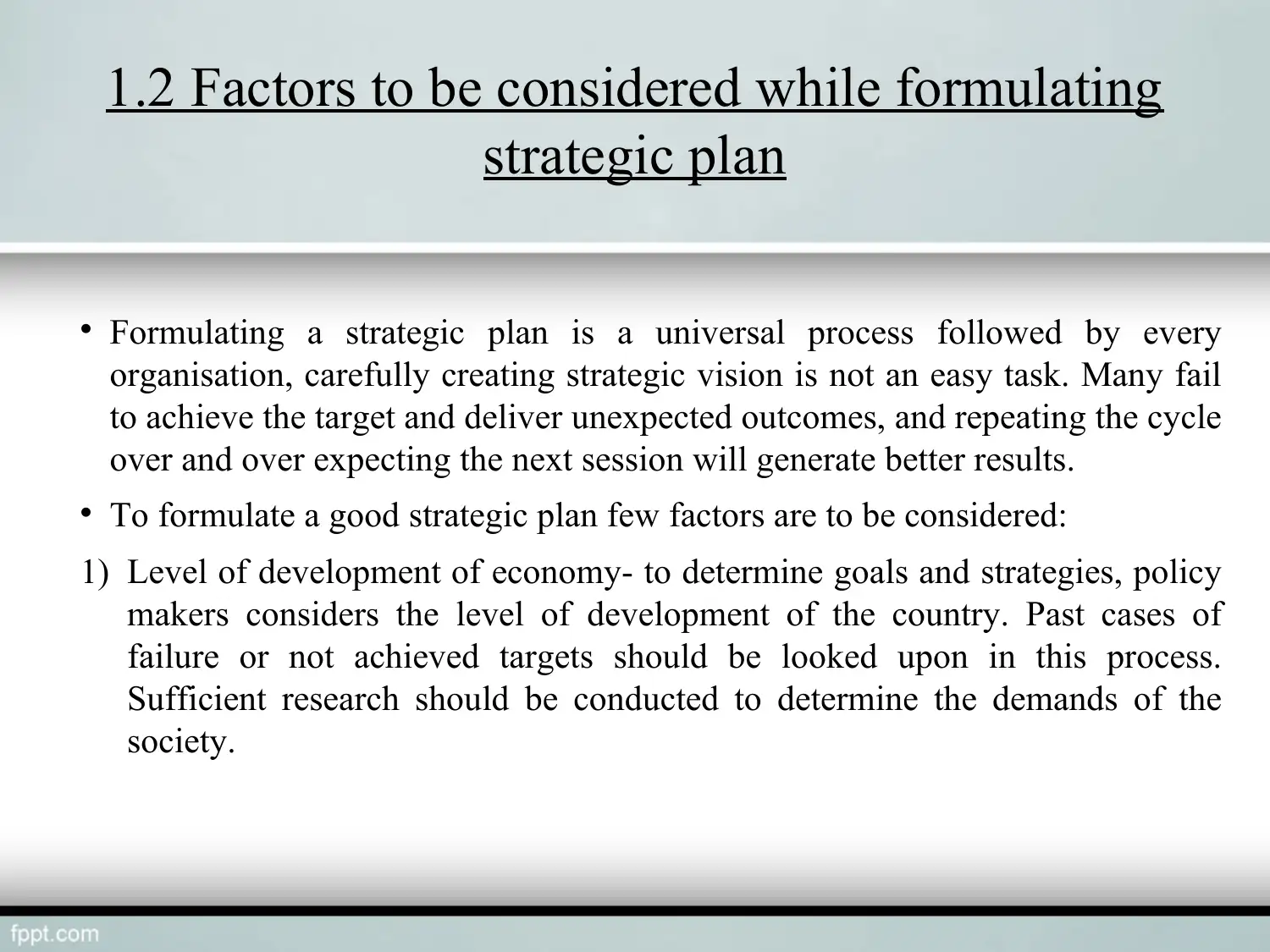
1.2 Factors to be considered while formulating
strategic plan
Formulating a strategic plan is a universal process followed by every
organisation, carefully creating strategic vision is not an easy task. Many fail
to achieve the target and deliver unexpected outcomes, and repeating the cycle
over and over expecting the next session will generate better results.
To formulate a good strategic plan few factors are to be considered:
1) Level of development of economy- to determine goals and strategies, policy
makers considers the level of development of the country. Past cases of
failure or not achieved targets should be looked upon in this process.
Sufficient research should be conducted to determine the demands of the
society.
strategic plan
Formulating a strategic plan is a universal process followed by every
organisation, carefully creating strategic vision is not an easy task. Many fail
to achieve the target and deliver unexpected outcomes, and repeating the cycle
over and over expecting the next session will generate better results.
To formulate a good strategic plan few factors are to be considered:
1) Level of development of economy- to determine goals and strategies, policy
makers considers the level of development of the country. Past cases of
failure or not achieved targets should be looked upon in this process.
Sufficient research should be conducted to determine the demands of the
society.
⊘ This is a preview!⊘
Do you want full access?
Subscribe today to unlock all pages.

Trusted by 1+ million students worldwide
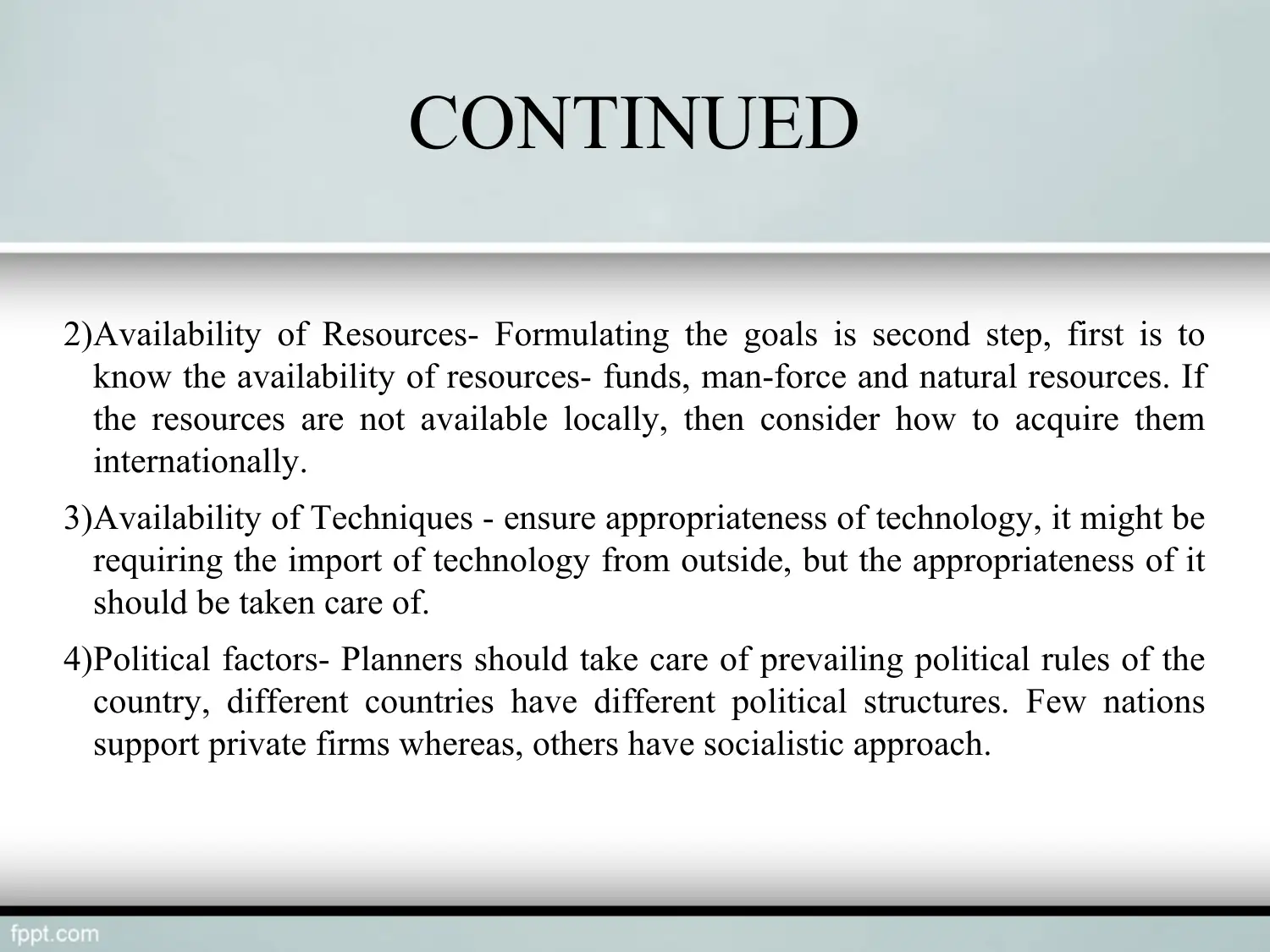
CONTINUED
2)Availability of Resources- Formulating the goals is second step, first is to
know the availability of resources- funds, man-force and natural resources. If
the resources are not available locally, then consider how to acquire them
internationally.
3)Availability of Techniques - ensure appropriateness of technology, it might be
requiring the import of technology from outside, but the appropriateness of it
should be taken care of.
4)Political factors- Planners should take care of prevailing political rules of the
country, different countries have different political structures. Few nations
support private firms whereas, others have socialistic approach.
2)Availability of Resources- Formulating the goals is second step, first is to
know the availability of resources- funds, man-force and natural resources. If
the resources are not available locally, then consider how to acquire them
internationally.
3)Availability of Techniques - ensure appropriateness of technology, it might be
requiring the import of technology from outside, but the appropriateness of it
should be taken care of.
4)Political factors- Planners should take care of prevailing political rules of the
country, different countries have different political structures. Few nations
support private firms whereas, others have socialistic approach.
Paraphrase This Document
Need a fresh take? Get an instant paraphrase of this document with our AI Paraphraser
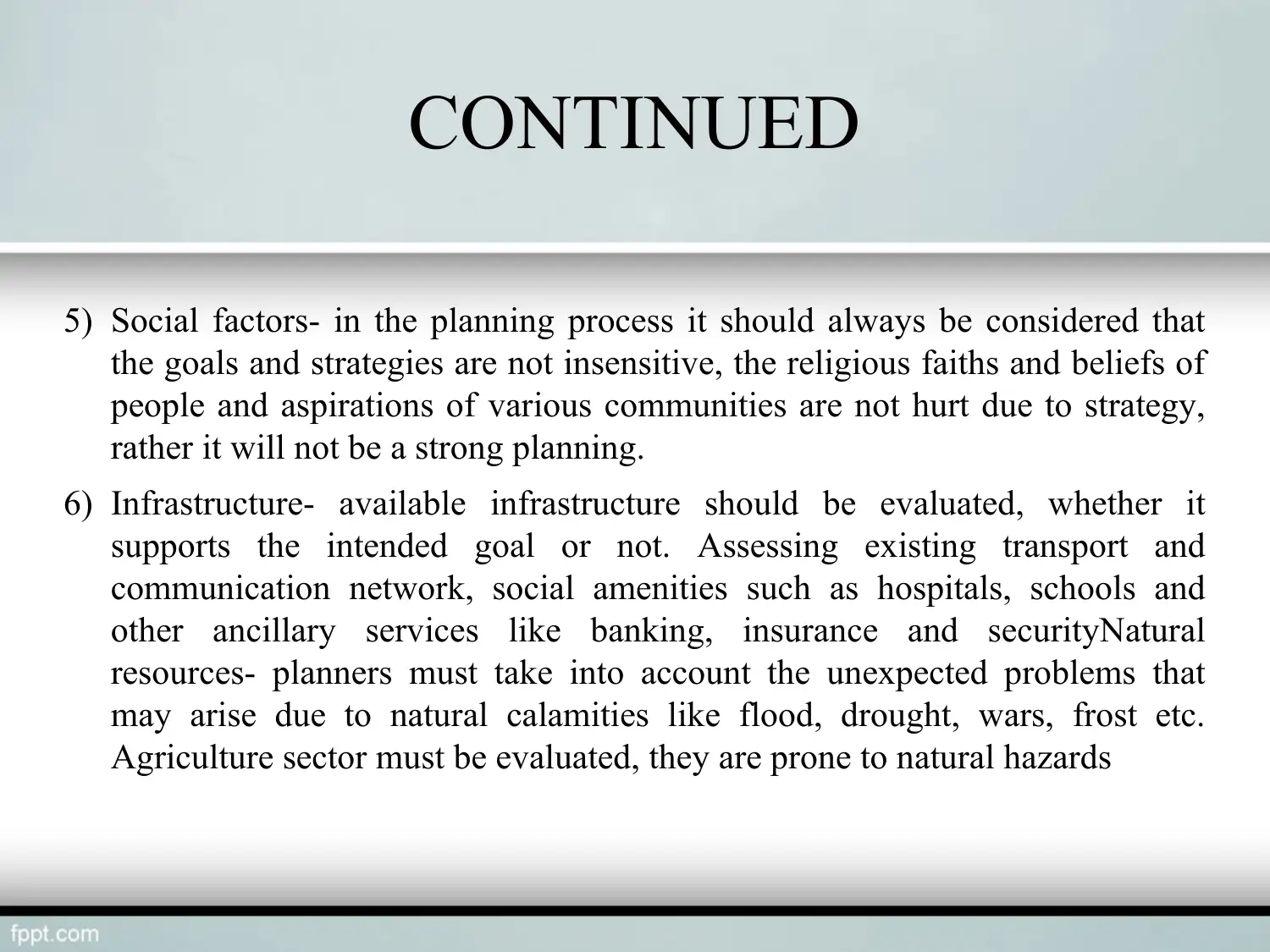
CONTINUED
5) Social factors- in the planning process it should always be considered that
the goals and strategies are not insensitive, the religious faiths and beliefs of
people and aspirations of various communities are not hurt due to strategy,
rather it will not be a strong planning.
6) Infrastructure- available infrastructure should be evaluated, whether it
supports the intended goal or not. Assessing existing transport and
communication network, social amenities such as hospitals, schools and
other ancillary services like banking, insurance and securityNatural
resources- planners must take into account the unexpected problems that
may arise due to natural calamities like flood, drought, wars, frost etc.
Agriculture sector must be evaluated, they are prone to natural hazards
5) Social factors- in the planning process it should always be considered that
the goals and strategies are not insensitive, the religious faiths and beliefs of
people and aspirations of various communities are not hurt due to strategy,
rather it will not be a strong planning.
6) Infrastructure- available infrastructure should be evaluated, whether it
supports the intended goal or not. Assessing existing transport and
communication network, social amenities such as hospitals, schools and
other ancillary services like banking, insurance and securityNatural
resources- planners must take into account the unexpected problems that
may arise due to natural calamities like flood, drought, wars, frost etc.
Agriculture sector must be evaluated, they are prone to natural hazards
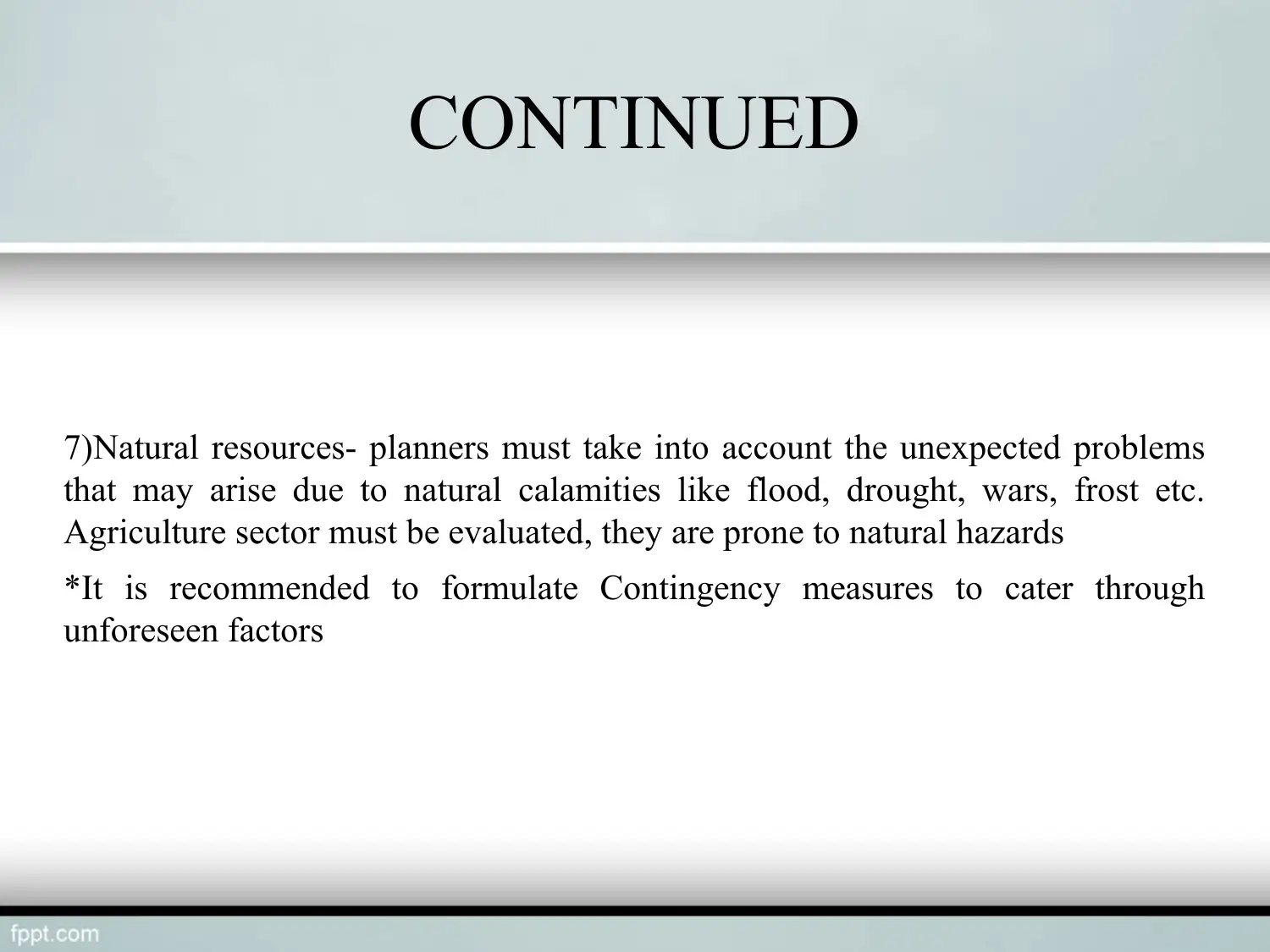
CONTINUED
7)Natural resources- planners must take into account the unexpected problems
that may arise due to natural calamities like flood, drought, wars, frost etc.
Agriculture sector must be evaluated, they are prone to natural hazards
*It is recommended to formulate Contingency measures to cater through
unforeseen factors
7)Natural resources- planners must take into account the unexpected problems
that may arise due to natural calamities like flood, drought, wars, frost etc.
Agriculture sector must be evaluated, they are prone to natural hazards
*It is recommended to formulate Contingency measures to cater through
unforeseen factors
⊘ This is a preview!⊘
Do you want full access?
Subscribe today to unlock all pages.

Trusted by 1+ million students worldwide
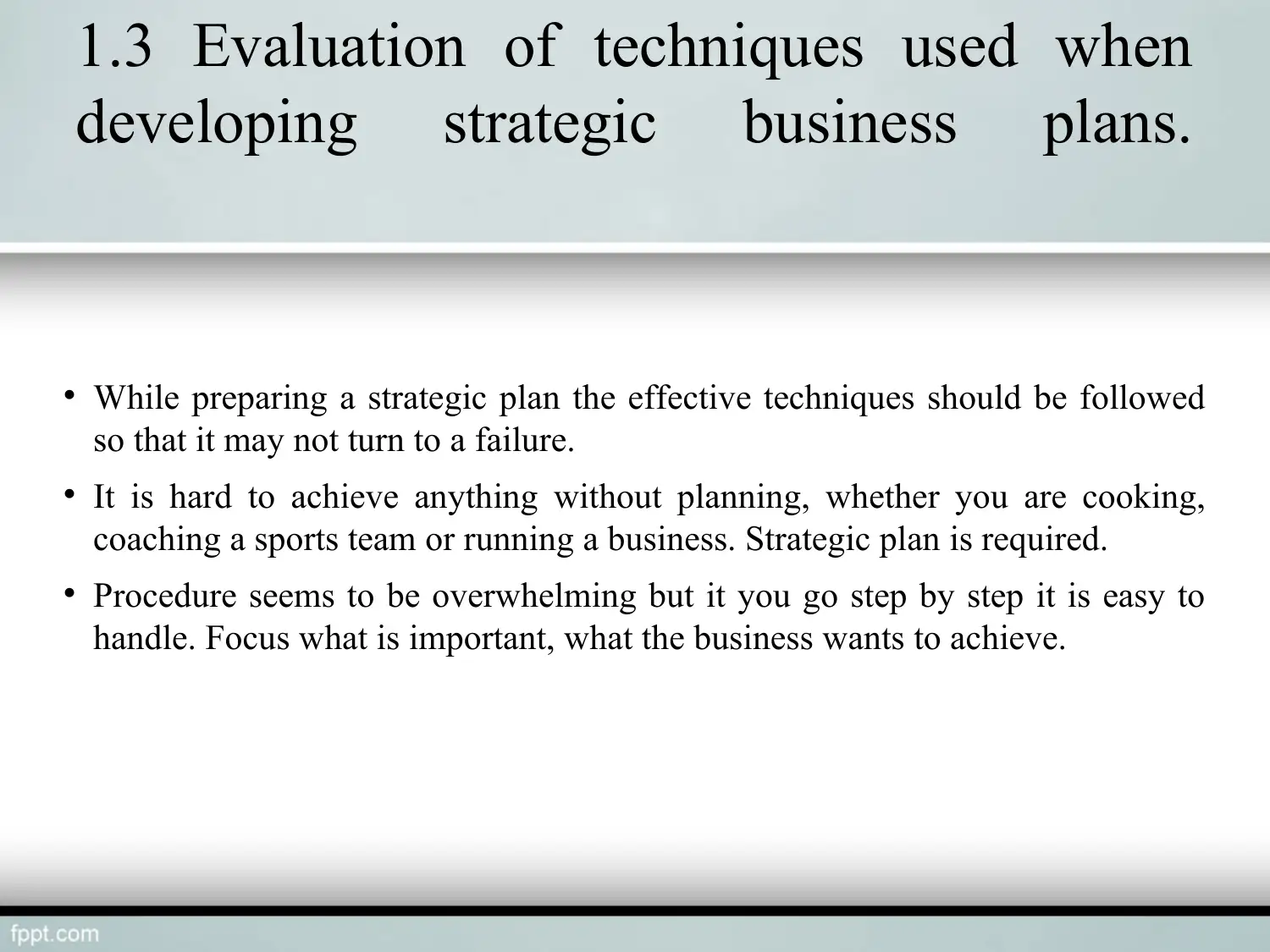
1.3 Evaluation of techniques used when
developing strategic business plans.
While preparing a strategic plan the effective techniques should be followed
so that it may not turn to a failure.
It is hard to achieve anything without planning, whether you are cooking,
coaching a sports team or running a business. Strategic plan is required.
Procedure seems to be overwhelming but it you go step by step it is easy to
handle. Focus what is important, what the business wants to achieve.
developing strategic business plans.
While preparing a strategic plan the effective techniques should be followed
so that it may not turn to a failure.
It is hard to achieve anything without planning, whether you are cooking,
coaching a sports team or running a business. Strategic plan is required.
Procedure seems to be overwhelming but it you go step by step it is easy to
handle. Focus what is important, what the business wants to achieve.
Paraphrase This Document
Need a fresh take? Get an instant paraphrase of this document with our AI Paraphraser
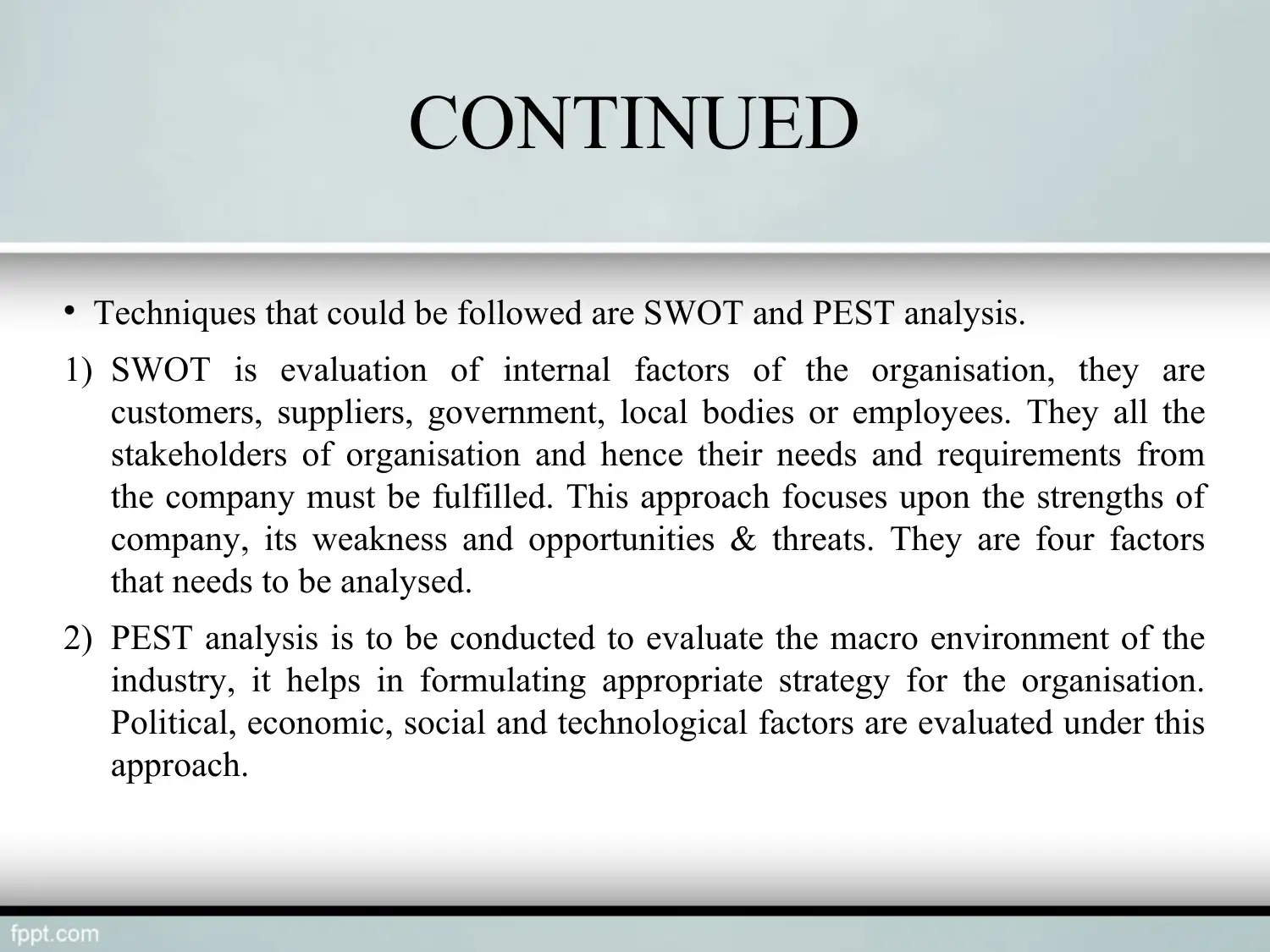
CONTINUED
Techniques that could be followed are SWOT and PEST analysis.
1) SWOT is evaluation of internal factors of the organisation, they are
customers, suppliers, government, local bodies or employees. They all the
stakeholders of organisation and hence their needs and requirements from
the company must be fulfilled. This approach focuses upon the strengths of
company, its weakness and opportunities & threats. They are four factors
that needs to be analysed.
2) PEST analysis is to be conducted to evaluate the macro environment of the
industry, it helps in formulating appropriate strategy for the organisation.
Political, economic, social and technological factors are evaluated under this
approach.
Techniques that could be followed are SWOT and PEST analysis.
1) SWOT is evaluation of internal factors of the organisation, they are
customers, suppliers, government, local bodies or employees. They all the
stakeholders of organisation and hence their needs and requirements from
the company must be fulfilled. This approach focuses upon the strengths of
company, its weakness and opportunities & threats. They are four factors
that needs to be analysed.
2) PEST analysis is to be conducted to evaluate the macro environment of the
industry, it helps in formulating appropriate strategy for the organisation.
Political, economic, social and technological factors are evaluated under this
approach.
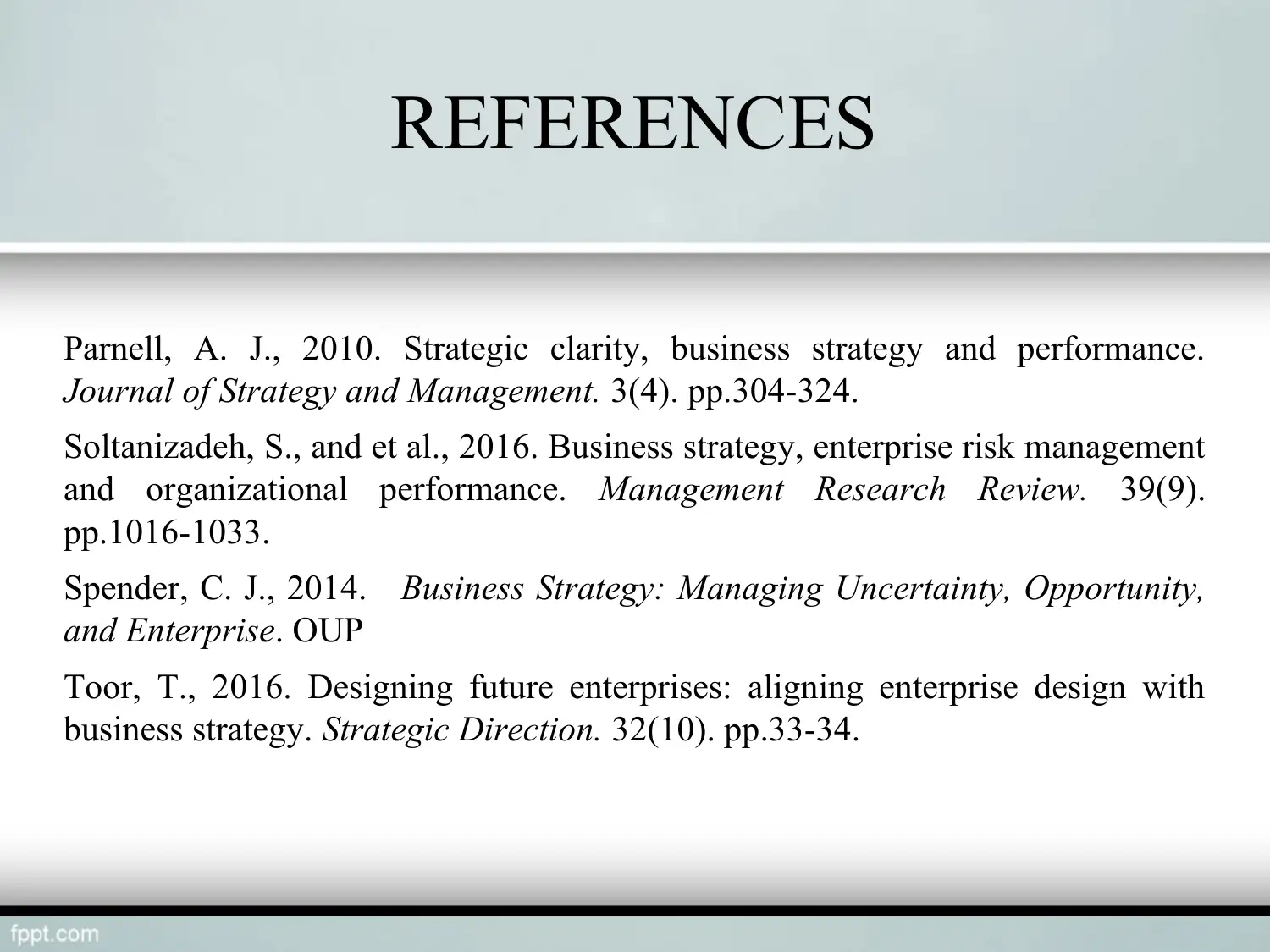
REFERENCES
Parnell, A. J., 2010. Strategic clarity, business strategy and performance.
Journal of Strategy and Management. 3(4). pp.304-324.
Soltanizadeh, S., and et al., 2016. Business strategy, enterprise risk management
and organizational performance. Management Research Review. 39(9).
pp.1016-1033.
Spender, C. J., 2014. Business Strategy: Managing Uncertainty, Opportunity,
and Enterprise. OUP
Toor, T., 2016. Designing future enterprises: aligning enterprise design with
business strategy. Strategic Direction. 32(10). pp.33-34.
Parnell, A. J., 2010. Strategic clarity, business strategy and performance.
Journal of Strategy and Management. 3(4). pp.304-324.
Soltanizadeh, S., and et al., 2016. Business strategy, enterprise risk management
and organizational performance. Management Research Review. 39(9).
pp.1016-1033.
Spender, C. J., 2014. Business Strategy: Managing Uncertainty, Opportunity,
and Enterprise. OUP
Toor, T., 2016. Designing future enterprises: aligning enterprise design with
business strategy. Strategic Direction. 32(10). pp.33-34.
⊘ This is a preview!⊘
Do you want full access?
Subscribe today to unlock all pages.

Trusted by 1+ million students worldwide
1 out of 12
Related Documents
Your All-in-One AI-Powered Toolkit for Academic Success.
+13062052269
info@desklib.com
Available 24*7 on WhatsApp / Email
![[object Object]](/_next/static/media/star-bottom.7253800d.svg)
Unlock your academic potential
Copyright © 2020–2025 A2Z Services. All Rights Reserved. Developed and managed by ZUCOL.





